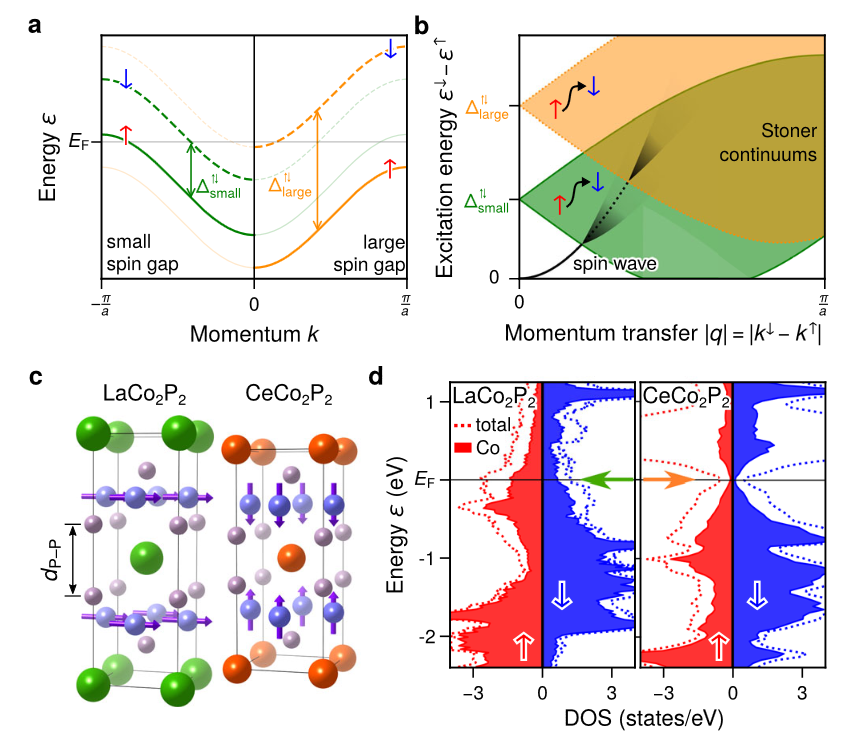Milestone in the quest for THz magnonic devices working at room temperature
Magnons or spin waves are elementary quasiparticles, which represent a collective motion of magnetic moments in ordered systems. Spin waves can propagate in materials and therewith transport a spin current. This spin flow requires no electrical charge transport and therefore no electrical losses creating Joule heating. Spin waves enclose a wide frequency range, from gigahertz up to a few hundreds of terahertz. The larger the excitation frequency, the faster are the magnon processes. However, the utilization of magnons in magnonic applications can be limited by their lifetime, which can range from a few tenths of a microsecond down to tens of femtoseconds, depending on their frequency and some features of the electronic structure6
Magnons hold great promise for classical and quantum computing, due to the excellent energy-efficiency and scalability of magnonic devices. Both fundamental and applied research in the field of magnonics undergo rapid growth, fueled by the recent demonstrations of metamaterials and devices capable of information processing based upon propagating spin waves. The prospect of making such devices also ultrafast, i.e. operating at many GHz or even THz, is a major driver for these research efforts.
Complementary metal–oxide–semiconductor (CMOS) is a type of metal–oxide–semiconductor field-effect transistor (MOSFET) fabrication process that uses complementary and symmetrical pairs of p-type and n-type MOSFETs for logic functions. CMOS technology is used for constructing integrated circuit chips, including microprocessors, microcontrollers, memory chips, and other digital logic circuits. In addition to reaching the THz regime, integration of magnons with existing CMOS technology is a major challenge in unlocking the full technological potential of magnonics. The typically considered insulating oxide materials, like ferrites, integrate, for example, poorly into monolithic microwave integrated circuits, and it becomes more and more clear that we need to explore the potential of metallic magnets as substitutes for those oxides.
One of the big challenges in finding suitable metallic magnets, both ferro- and antiferromagnetic, is that Stoner spin-flip excitations very strongly damp magnons in these materials, leading to very short magnon lifetimes towards the THz regime.

A team of researchers has now identified 1 a room temperature, metallic antiferromagnet CeCo2P2 with an unusually high ordering temperature of TN = 440 K in which nearly undamped spin waves can be generated in the tens of THz regime. Using state-of-the art ab initio calculations the researchers have found that CeCo2P2 should also exhibit a large Stoner gap as well as steep magnon dispersions with magnon energies reaching several hundred meV. Both are prerequisites for long lived magnons in the THz regime.
Together with its good metal properties and its very high ordering temperature CeCo2P2 seems to be an extremely promising material for room temperature THz magnonics. Animated by our theoretical results, we performed high-resolution RIXS measurements, which can directly probe spin waves and their damping. In agreement with predictions, the team observes high-energy magnons up to THz energies with very long lifetimes.
A detailed analysis of the experimental data shows lifetimes of 0.2 to 0.4 ps even at very high magnon energies (frequencies) above 150 meV (35 THz). The reason for these unusual properties in CeCo2P2 lies in intricacies of the electronic structure around the Fermi level. This is clearly demonstrated by comparison with LaCo2P2 where it is shown both experimentally and theoretically how the Ce to La substitution immediately restores the typical strong damping of high-frequency magnons in metals.
This identification of very long-lived THz magnons in a high-temperature metallic magnet could be an important milestone in the quest for THz magnonic devices working at room temperature conditions. For the future, it will be interesting to see how structural units of CeCo2P2 perform when integrated into different functional magnonic heterostructures, where further parameters, like interfacial stress and strain, charge transfer, etc become available for tuning material properties.
Author: César Tomé López is a science writer and the editor of Mapping Ignorance
Disclaimer: Parts of this article may have been copied verbatim or almost verbatim from the referenced research paper/s.
References
- G. Poelchen, J. Hellwig, M. Peters, D. Yu. Usachov, K. Kliemt, C. Laubschat, P. M. Echenique, E. V. Chulkov, C. Krellner, S. S. P. Parkin, D. V. Vyalikh, A. Ernst & K. Kummer (2023) Long-lived spin waves in a metallic antiferromagnet Nature Communications doi: 10.1038/s41467-023-40963-x ↩